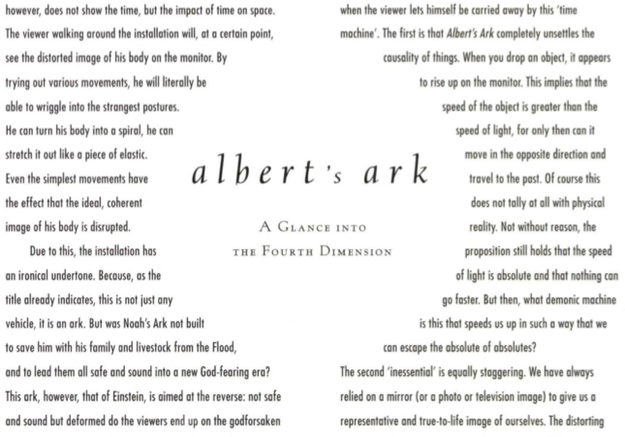At last a vehicle has been designed for the greatest inventor of the 20th century: Albert Einstein. While Gyro Gearloose has always been able to enjoy the luxury of a small flying saucer, with its technical gadgets perfectly geared to his bizarre inventor's mind, nobody hos ever made a vehicle to match Einstein's genius. Just recently, however, somebody has, and the prototype is called Albert's Ark.
Albert's Ark is a cross between a large sundial made of stone and an ultra-modern, opened-out 'video dock'. Because the colossus is opened-out and shows its intricate inner mechanism, it evokes the suggestion that the pseudo old-fashioned sundial is just as advanced inside as an atomic clock. The monitor of the 'video dock', however, does not show the time, but the impact of time on space. The viewer walking around the installation will, at a certain point, see the distorted image of his body on the monitor. By trying out various movements, he will literally be able to wriggle into the strangest postures.
He can turn his body into a spiral, he can stretch it out like a piece of elastic. Even the simplest movements have the effect that the ideal, coherent image of his body is disrupted.
Due to this, the installation has an ironical undertone. Because, as the title already indicates, this is not just any vehicle, it is an ark. But was Noah's Ark not built to save him with his family and livestock from the Flood, and to lead them all safe and sound into a new God-fearing era? This ark, however, that of Einstein, is aimed at the reverse: not safe and sound but deformed do the viewers end up on the godforsaken screen, not piety but bewilderment is the result of watching their own bodies 'spread out' in space.
Whereas the flat screen normally presents us with the projection of a three-dimensional body, Albert's Ark shows us the projection of a body with four dimensions. Due to this, the body can be observed at different times simultaneously and due to this it can spread out in space in this way. The live-aspect of the installation is not only important because movement and distortion are thus related directly to each other, but also because the passing of time is only visible when there are 'signs of life', when a viewer ventures to come near this machine. The installation is a kind of vitality etector, separating the animate from the inanimate, the alive from the dead.
In order to make the impact of time on space visible, Bill Spinhoven developed the Time Stretcher in 1988. The fact that nowhere in space is time identical - although the differences are only perceptible on a cosmic scale - intrigued him so much that he worked out a machine capable of enlarging these trifling differences to a human scale. The Time Stretcher functions as a magnifying glass, allowing us a glance into the fourth dimension (indeed, another installation in which Bill Spinhoven applied his Time Stretcher is called Look Out Into the Fourth Dimension).
However, there are two disturbing 'inessentials' which emerge when the viewer lets himself be carried away by this 'time machine'. The first is that Albert's Ark completely unsettles the
causality of things. When you drop an object, it appears to rise up on the monitor. This implies that the speed of the object is greater than the speed of light, for only then can it move in the opposite direction and travel to the past. Of course this does not tally at all with physical reality. Not without reason, the proposition still holds that the speed of light is absolute and that nothing can go faster. But then, what demonic machine is this that speeds us up in such a way that we can escape the absolute of absolutes?
The second 'inessential' is equally staggering. We have always relied on a mirror (or a photo or television image) to give us a representative and true-to-life image of ourselves. The distorting mirror is in fact a cautious, low tech undermining of this image, whereas Albert's Ark radically puts an end to this illusion. We will have to recognise that the stretched-out bodies on the monitor are our true selves. To grasp this appearance in its entirety, we must moke use of what relativists call the world line, the orbit of a body through a four dimensional universe of space and time. The Time Stretcher can only moke a small part of this orbit visible. But imagine the possibility of watching your world line, from birth to death, in all its magisterial, misshapen and impenetrable configuration, very slowly pass by on the screen. That would be the absolute spectacle of time.
Mediamatic Magazine vol 5#1+2 1 Jan 1990
Albert's Ark
The Artists
A glance into the Fourth Dimension
